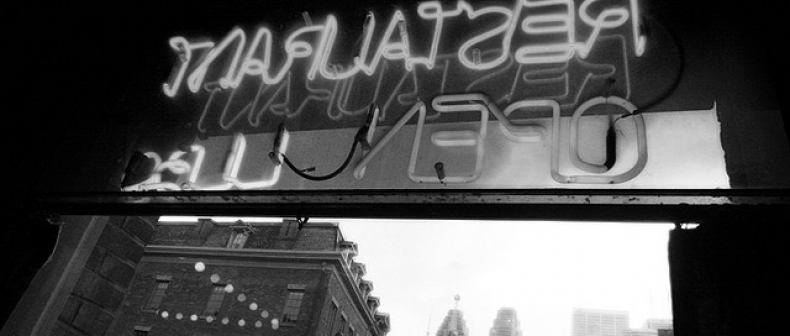
Image: Flickr, hogtownproject
A friend of mine recently moved back to Toronto after living for a year in Europe. On her maiden voyage to Sweden, she made a relatively serious discovery: Scandinavians (yes, those tall, attractive descendants of Vikings) love Canada. They find us fascinating. The denizens of young Sweden want nothing more than a taste of boreal forest air, a hike through the Rocky Mountains, or a real, authentic lumberjack shirt.
I’ve had confirmation of similar longings from acquaintances the world over. A friend from England still counts her first Canadian expedition as her greatest conquest. An Italian ex-roommate still wonders at my land of two-lane streets and polite drivers. People elsewhere in the world actually think we’re pretty cool. Which is why it doesn’t make sense for Canada to keep sticking to its perpetual inferiority complex. It’s actually kind of annoying.
Toronto hasn’t had an easy run of it either. When people aren’t dissing Alberta (we’re jealous of their cheap rent and bigger paycheques), they’re almost certainly saying something unkind about Toronto. Sure, you won’t find real lumberjacks here, but at least we’ve got the gift shops that will let you say you did. And the truth is, they’re kind of jealous of us too.
On a Friday last month, I spent my lunch break at Queen and Bathurst watching construction workers as they finally took the plastic tarp down from the huge two-storey building on the southeast corner. Two years ago, that building was the Big Bop – the three-stage club comprising the Kathedral, the Reverb, and Holy Joe’s. It was that scuzzy sort of place for punk and hardcore bands that sat well with high schoolers and the 905 crowd. And as we all remember, it was painted bright purple.
But on that Friday afternoon, when they first took down the tarp and scaffolding, the building was suddenly a gleaming red vision with yellow brick trim. I felt like I’d just witnessed a historic, symbolic moment. Toronto was growing up.
It’s on days like those that I feel like this city is finally shedding its half-century-long awkward adolescence for an actual sense of identity, and a new respect for its childhood. These days heritage building restoration projects abound, and remind us that Toronto in the 1800s was actually a thing. Meanwhile, blogs and books have started to herald a new era of unabashed love for the city. You could say we’re living a Canadian dream right here – one that even the Scandinavians seem to covet.
The “Canadian Dream” (if we’re going to call it that) is about opportunity. Toronto is a place where you can still live in a big city, but still start a small business in your neighbourhood. According to writer Nadine Dolly, “It’s one of those cities where if you have a dream and you invest in it, there’s still a way to somehow make it happen.” It sounds eerily similar to something the dream-deluded Willy Loman in Death of a Salesman‘s would say. Except in Toronto’s case, the dream is still very much alive.
In 2010, Nadine and Kristie Macor published The Hogtown Project, a book of photos and travel writing about Toronto and its neighbourhoods. It’s one of the only travel books you’ll find about Toronto that actually feels like it was made by people who live here. That’s because they do.
“The City itself didn’t give us a lot of support for the book, but we received a lot of support from the people in the book,” says Nadine. “So you form your own collective to make things happen. You see that kind of thing in stores in the fashion district, where a collective of artists get together to show their work. They’re going to do it one way or another. And that’s why you see all these new places popping up all the time. The community is learning to support itself better. So it’s kind of like, ‘the City be damned – we’re going to do it anyway.’”
Kristie, who took photographs for the book, hails from Trinity Bellwoods and explains, “If you go to Dundas and Ossington, there are always new shops. They’re very independent – you know it’s someone who’s probably just starting their first business, like a lot of vintage clothing shops and cafes. It’s inspiring to see people starting things.”
But somehow the Tourism Toronto vision of our city doesn’t actually tap into our DIY start-up dreamscape. Newcomers don’t get pointed to the independent coffee shops or art collectives. If anything, they find them by accident. Back in the cement centre of the city, the double-decker tour buses that lumber through Toronto every summer will continue to drop you off at Yonge Street gift shops selling Mountie postcards and beaver keychains.
“Yonge Street was the centre of Toronto for a long time. But it’s not anymore,” says Kristie. “There’s nothing there. Everything there that was colourful and amazing about the city has moved on to other parts of it. So it’s weird that there are tours all over Yonge Street.”
It’s what the naive tourist will usually see of Toronto, and for some reason, it’s regrettably easy to believe that Toronto is synonymous with Yonge Street. Thankfully, if you head webside, you’ll see a new surge in new Toronto-based blogs that are out to prove the opposite.
Stephan Petar started Why I Love Toronto as a bet over whether he could come up with 365 reasons why he loved the city. He was born and raised in Toronto’s westend, but he’s still learned a lot about the city’s history in the process of writing the blog.
“I didn’t know that 1 Spadina Crescent was an old military college where Amelia Erhart used to work,” Stephan recalls. “Amelia Erhart used to live in Toronto for a few years, and she was a nurse there – and I didn’t know that. I also didn’t know that it was the eyeball bank of Canada.”
History is a big part of appreciating a city. The proof is in the landmarks of the not-so-distant past that still manage to make us nostalgic. “I still remember the night of Nuit Blanche in 2008,” says Stephan. “Everyone was just staring at the Sam the Record Man sign, and taking pictures, and we didn’t understand why. And then someone told me it’s the last day it’s ever going to be lit. So we were like, ‘oh my god, we have to take pictures and stare at it for a little while because this is it. This is a part of history that’s going to disappear.’”
Maybe it’s just me, but these days it seems Toronto’s history and archival photos are, well, a thing. I’ll see friends on Facebook excitedly sharing photos of 1920s Bloor Street and that butcher’s shop that’s now a bubble tea joint. Or how about your intersection on St. Clair West that once thrived on horse-drawn carriages? The Toronto Archives’ Flickr stream has probably never seen this much traffic. And maybe part of recognizing our Toronto as the enviable place that it is will come from recognizing its past.
Carla Mesa Guzzo is another Toronto blogger who started Toronto Travelers with a friend last year to collect stories about our everyday experiences with the city. “I think that more recent generations are finally starting to sort of look up and say, ‘We have this great thing right in our backyard and maybe we should celebrate it a little more.’”
Still, as money and new businesses diffuse through formerly run-down neighbourhoods, you lose things. We’ve lost places like Pages, and This Ain’t The Rosedale Library – places that seemed to have been around forever.
“I realize that cities always change, landmarks often get torn down,” says Carla. “But I think that we’re starting to see more of the importance of these things, and we’re trying to preserve them a little bit more.”
Toronto has its problems just like any other city. We won’t be able to restore every heritage building befitting of the Canadian Dream of new opportunity and not-so-new history. The trick is realizing we’ve got something pretty great, before everyone realizes it’s cool and ruins our fun.
____
Erene Stergiopoulos writes for Toronto Standard. Follow her on Twitter @fullerenes.
Subscribe to our newsletter.














